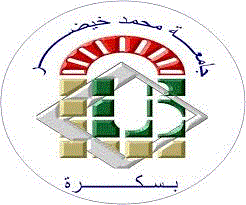| Titre : | Influence of doping on the structural properties of a BNT-type ceramics |
| Auteurs : | Selsabil SOUDANI, Auteur ; Abdelhek MEKLID, Directeur de thèse |
| Type de document : | Mémoire magistere |
| Editeur : | Biskra [Algérie] : Faculté des Sciences Exactes et des Sciences de la Nature et de la Vie, Université Mohamed Khider, 2025 |
| Format : | 1VOL.(101p) / ill.couv.ill.en coul / 30cm |
| Langues: | Anglais |
| Langues originales: | Anglais |
| Mots-clés: | Perovskite, BNT, molten salts, catalysts, XRD, FTIR, SEM |
| Résumé : |
The main objective of this work is to synthesise and characterise the structural, physical and photocatalytic properties of a new type of BNT ceramic with an ABO3 perovskite structure in the system: (Na0.5 Bi0.5)1-x Smx (Ti0.8 Zr0.2)0.9 (Fe1/5 Zn1/5 In3/5)0.1, where x=0, 2%. We sought to optimise the structural, morphological and optical properties of this material to improve its photocatalytic activity. The study was carried out using a substitution procedure at sites A and B, where the various catalysts were prepared by the molten salt method and then calcined at 900°C. Their characterisation was carried out using various techniques: X-ray diffraction (XRD), Fourier transform infrared spectroscopy (FTIR), Scanning electron microscopy (SEM) and UV-visible spectroscopy. Structural analyses (XRD, FTIR) confirmed the formation of a tetragonal perovskite structure with space group P4bm for all compositions, SEM analysis shows that the grain size 2.87 μm with a uniform distribution. UV-visible absorption measurements were used to determine the energy gaps (Eg) of the different samples (samarium undoped BNT (Sm) Eg = 2 .22eV, samarium doped BNT (BNT X= 2%) Eg = 2.14eV). Photocatalytic tests, carried out on the degradation of methylene blue under solar irradiation, showed a maximum degradation efficiency of 63.44% after 180 min. The reaction kinetics followed a pseudo-first-order model, with a maximum apparent rate constant (kapp) of 0.00535 min-¹ for the BNT X= 2% catalyst, indicating superior photocatalytic activity. The samples were sintered at 1000, 1050, 1100 and 1150 °C, respectively, to optimise the sintering temperature at which the sample density is maximised. These results indicate that this material may be a promising candidate for the degradation of organic pollutants in aqueous solution. |
| Sommaire : |
General Introduction 01 Bibliographic References 03 Chapter I : BIBLIOGRAPHY I.1 Introduction 04 I.2 General Information on ceramics 04 I.2.1 Classification of ceramic 05 I.3 Perovskite structure 06 I.3. 1 Crystalline structure 07 I.3. 2 Ideal perovskite structure 07 I.3. 3 Complex perovskite structure 07 I.3. 4 Stability of the structure 07 I.3. 4 .1 Tolerance factor 08 I.3. 4 .2 Stoichiometric condition 09 I.3. 4 .3 Electroneutrality condition 09 I. 4 Properties of perovskites 09 I. 4.1 Electrical properties 09 I. 4.1.1 Piezoelectricity 09 I. 4.1.1.1 Symmetry and piezoelectricity 11 I. 4.1.2 Pyroelectricity 13 I. 4.1.3 Ferroelectricity 13 I. 4.1.3.1 Ferroelectric domains 14 I. 4.1.3.2 The Curie point 15 I. 4.1.4 Dielectricity 16 I. 4.2 Photocatalytic properties 17 I. 4.3 Catalytic properties 17 I. 5 Generalities on BNT perovskite-type oxide 17 I. 5.1 History 17 I. 5.2 The BNT-type structure 18 I. 5.3 The dielectric and ferroelectric properties of BNT 18 I. 5.4 Advantages and disadvantages of BNT 19 I. 6 Perovskite doping 19 I. 6. 1 Definition of doping 19 I. 6. 2 Doping purposes 20 I. 6. 3 Doping techniques 20 I. 6. 3.1 Ion implantation doping 20 I. 6. 3.2 Diffusion doping 20 I. 6. 3.3 Doping by laser technique 20 I. 6. 3.4 Doping by epitaxy 21 I. 6. 4 Classification of doping agents 21 Bibliographic References 23 I .1 Introduction 27 II .2 The Molten Salt method 28 II .2.1 The advantages of the molten salt synthesis MSS 28 II .2.2 The important purpose of using molten salts synthesis 30 II .2.3 The role of molten salts 30 II .3 Experimental procedure 30 II.3.1 Starting products 30 II.3.1.1 Base oxides 31 II.3.1.2 Dopants 33 II.3.1.2.1 Doping at site A 34 II.3.1.2.2 Dopings at site B 34 II.3.2 Powder preparation 36 II .3.2.1 Weighing and mixing 36 II.3.2.2 Grinding with salts 36 II.3.2.3 Heat treatment 38 II .3.2.4 Grinding and drying procedure of pellets 40 II.3.2.5 Salt washing 40 II.3.2.6 drying 41 II.3.2.7 Regrinding 42 II.3.2.8 Shaping 42 II.3.2.9 Sintering 43 II.4 Structural characterisation techniques for calcined powders and sintered ceramics 45 II.4.1 Study of the structure by X-ray diffraction 45 II.4.2 Measurement of density (d) 47 II.4.3 Measurement of porosity (P) 48 II.4.4 SEM analysis 49 II.4.5 FTIR analysis 50 II.5 Photocatalysis 52 II.5 .1 Introduction 52 II.5 .2 Dyes 52 II.5 .2 .1 Definition of a dye 52 II.5 .2 .2 Classification of dyes 53 II.5 .3 Photocatalysis 53 II.5 .3.1 Definition of photocatalysis 53 II.5 .3.2 Principles and mechanisms of photocatalysis 54 II.5 .3.3 Factors affecting the efficiency of the photocatalytic process 56 II.5 .4 UV-visible spectroscopy 58 Bibliographic References 65 III.1 Introduction 70 III.2 Synthesis and production of ceramics 70 III. 3 Stability conditions of the perovskite structure 71 III.3.1 Electroneutrality condition 72 III.3.2 Stoichiometric condition 72 III.3.3 Geometric condition 73 III.4 Powder characterisation 74 III.4 .1Characterisation of powders by infrared spectroscopy 74 III.4.1.1. X-ray diffraction analysis 74 III.4.2. Characterisation of powders by infrared spectroscopy 80 III.4.3. Morphological study of BNT ceramics 82 III.4.3.1. Scanning electron microscopy (SEM) characterization 82 III.4.3.2. Density 84 III.4.3.3. Porosity 86 III.5. Optical characterisation by UV-Visible 89 III.5.1. Methylene blue (MB) self-degradation test 90 III.5.2. Study of the photodegradation of methylene blue 91 III.5.2.1. Experimental protocol 91 III.5.2.2. Photocatalytic activity Sm doped and undoped BNT ceramics 92 III.5.2.3. Kinetic study of MB degradation by BNT pure and BNT doped 96 III.6. Conclusion 97 Bibliographic References 98 General conclusion 101 |
| Type de document : | Mémoire master |
Disponibilité (1)
| Cote | Support | Localisation | Statut |
|---|---|---|---|
| MCH/657 | Mémoire master | bibliothèque sciences exactes | Consultable |





